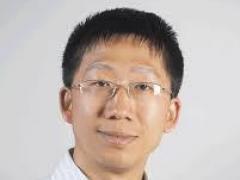New research tackles a central challenge of powerful quantum computing

Credit: UMass Amherst
To build a universal quantum computer from fragile quantum components, effective implementation of quantum error correction (QEC) is an essential requirement and a central challenge. QEC is used in quantum computing, which has the potential to solve scientific problems beyond the scope of supercomputers, to protect quantum information from errors due to various noise.
Published by the journal Nature, research co-authored by University of Massachusetts Amherst physicist Chen Wang, graduate students Jeffrey Gertler and Shruti Shirol, and postdoctoral researcher Juliang Li takes a step toward building a fault-tolerant quantum computer. They have realized a novel type of QEC where the quantum errors are spontaneously corrected.
Today’s computers are built with transistors representing classical bits (0’s or 1’s). Quantum computing is an exciting new paradigm of computation using quantum bits (qubits) where quantum superposition can be exploited for exponential gains in processing power. Fault-tolerant quantum computing may immensely advance new materials discovery, artificial intelligence, biochemical engineering and many other disciplines.
Since qubits are intrinsically fragile, the most outstanding challenge of building such powerful quantum computers is efficient implementation of quantum error correction. Existing demonstrations of QEC are active, meaning that they require periodically checking for errors and immediately fixing them, which is very demanding in hardware resources and hence hinders the scaling of quantum computers.
In contrast, the researchers’ experiment achieves passive QEC by tailoring the friction (or dissipation) experienced by the qubit. Because friction is commonly considered the nemesis of quantum coherence, this result may appear quite surprising. The trick is that the dissipation has to be designed specifically in a quantum manner. This general strategy has been known in theory for about two decades, but a practical way to obtain such dissipation and put it in use for QEC has been a challenge.
“Although our experiment is still a rather rudimentary demonstration, we have finally fulfilled this counterintuitive theoretical possibility of dissipative QEC,” says Chen. “Looking forward, the implication is that there may be more avenues to protect our qubits from errors and do so less expensively. Therefore, this experiment raises the outlook of potentially building a useful fault-tolerant quantum computer in the mid to long run.”
Chen describes in layman’s terms how strange the quantum world can be. “As in German physicist Erwin Schrödinger’s famous (or infamous) example, a cat packed in a closed box can be dead or alive at the same time. Each logical qubit in our quantum processor is very much like a mini-Schrödinger’s cat. In fact, we quite literally call it a `cat qubit.’ Having lots of such cats can help us solve some of the world’s most difficult problems.
“Unfortunately, it is very difficult to keep a cat staying that way since any gas, light, or anything leaking into box will destroy the magic: The cat will become either dead or just a regular live cat,” explains Chen. “The most straightforward strategy to protect a Schrodinger’s cat is to make the box as tight as possible, but that also makes it harder to use it for computation. What we just demonstrated was akin to painting the inside of the box in a special way and that somehow helps the cat better survive the inevitable harm of the outside world.”
###
Co-authors also include Brian Baker and Jens Koch from Northwestern University.
Media Contact
Patty Shillington
[email protected]
Original Source
https:/
Related Journal Article
http://dx.




